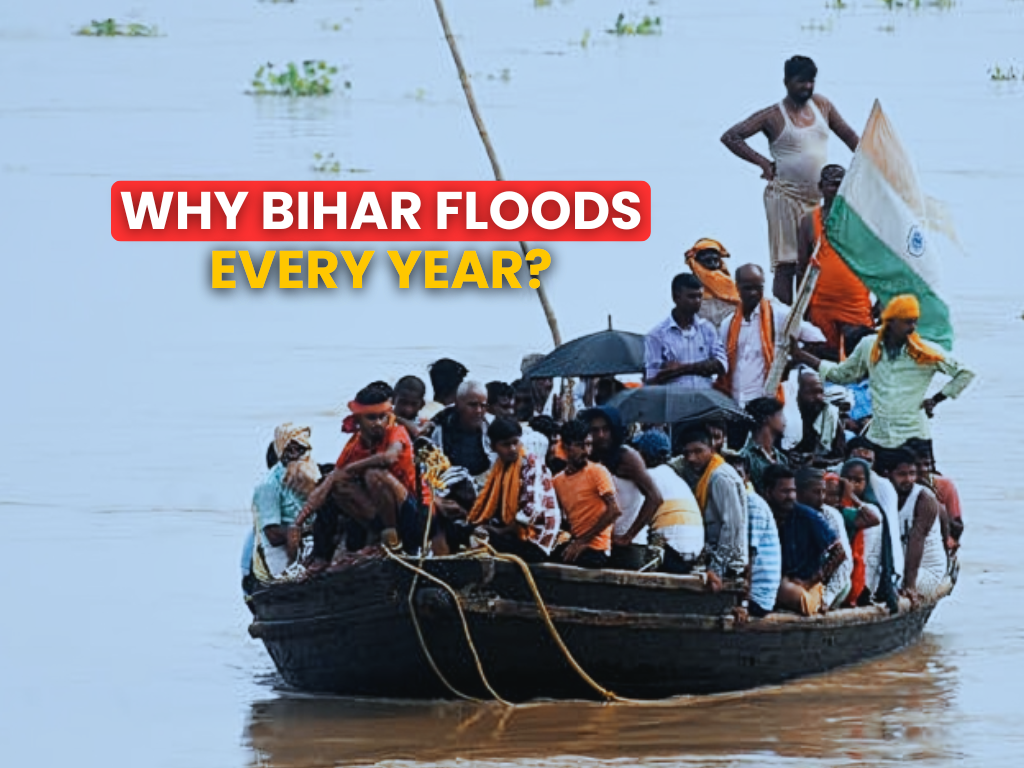Why Bihar Floods Every Year? 6 Brutal Points Everyone Ignores

Bihar floods affect millions of people every year. Houses are swept away, people settle in temporary camps or are forced to migrate. This is not a new problem or a seasonal tragedy – it has been recurring from the time of independence. Despite of this severe disaster that could be controlled by strategic planning and projects, Bihar floods every year.
We will be talking in detail about the Bihar floods including the reasons behind them, the political inaction, the broken infrastructure, and what solutions need to be adopted. Feel free to use the following Table of Contents to navigate as per your preference:
Table of Contents
The Harsh Reality of Bihar Floods
Bihar continues to be India’s most flood-prone state. Around 76% of North Bihar’s population is prone to severe flooding. Yes! 3 out of 4 people in North Bihar suffer from SEVERE flooding every single year. Nearly 73% area of entire Bihar (which is over 68,000 square kilometers) is flood affected.
Despite of being the state where India’s 22% of flood-affected population lives, we don’t see any political strategy for tackling this grave issue. Bihar alone has India’s 16.5% of total flood-affected area. Bihar is not a wasteland! Due to many Himalayan rivers flowing, it has India’s most fertile soil. But the same rivers have become a nightmare for Bihar’s population. And ignoring this precious area is not at all justified.
Economic Damage Due to Bihar Floods
Every year, we lose atleast ₹1,500 crore worth agricultural produce due to Bihar floods. Since 1979, over 9,500 lives were lost due to the floods. In 2017, more than 17 million people were affected across 19 districts of Bihar. In the same year, over 514 people were killed. In 2008, over 3 million people were forced to displace due to damage to the embankments made on the Kosi river.
The Cure Became the Curse
Since the 1950s, government built more than 3,800 kilometres of embankments to stop Bihar floods. But the plan which was meant to be the solution actually made the problem worse.
Embankments were built of rivers like Kosi, Gandak and Bagmati. The trapped silt which raised the height of riverbeds. This increased the chances of overflow and caused more aggressive floods.
In 1954, when Bihar had only 160 km of embankments, the flood prone area was nearly 2.5 million hectares. But, when it was increased to 3,700 km of embankments in 2016, 7.2 million hectares of area became flood prone. This became a disaster for Bihar.
Political Silence & Ignorance
Bihar has been under the rule of NDA (National Democratic Alliance) for more than a decade now. Both the centre and state are controlled by the same alliance. In every Lok Sabha elections, NDA gets the maximum number of seats from Bihar. But, despite of giving full power to the government, it stays ignorant to the repetitive disaster. All they would do is damage control!
More than ₹1000 crore were allocated last year for Bihar flood victims. The relief funds just comes as charity instead of a long term solution. It has been more than 75 years since we got independence, but Bihar still is not free from floods.
All it required was political will. But, no concrete steps were taken due to which Bihar drowns every single year. People are stuck in the same vicious cycle – they struggle for survival even, forget growth.
It’s Not Just Bihar’s Problem
This is not just the problem of North Bihar or Bihar. This issue must be treated as national interest. Because as we discussed, Bihar alone makes the 22% of India’s total flood prone population.
Also, Bihar has India’s most fertile land for agriculture and it provides a major amount of food grains to India. But, when floods destroy crops and destroy fields, the potential is not used properly which turns into a major economic loss. It affects national food supply chains.
Bihar doesn’t grow because no one wants to set up factories in a flood prone area. This is a major setback to Bihar’s economy and well as the GDP of India. And not even get me started on the relief funds – thousands of crore rupees are spent per year for damage control. Every Indian taxpayer pays for the neglect. Biharis have to migrate to other states due to this same reason.
What Needs to be Done?
Experts have suggested multiple actionable plans to control Bihar floods. First on the list would be making a compatible dam on Nepal border. To make this a reality, the central government must work with Nepal. The actual probelm with Nepal is that, the dam at Nepal borders is not capable enough to handle the rising pressure from the river. If the water is not released, it would break the dam which would be even more worse, so the authorities release it and Bihar floods.
Apart from that, the flood prone areas must have access to early warning systems. The Ganga river along with the other rivers must be cleared from the excess silt that raises the riverbeds. River linking projects that divert the water to other regions are a need. But no steps were taken to make this a reality. Political will is missing, no steps were taken to establish co-ordination between India and Nepal, and between Centre and State.
The Farakka Barrage in Kolkata deposits nearly 640 million tonnes of silt into the Ganga river every year. This further aggravates the Bihar floods. Steps must be taken to stop this.
Conclusion
Bihar floods are not just about monsoon and rainfall, they show failed planning and political neglect. This must be treated as a topic of national priority. Loosing thousand of crores annually and reimbursing it with relief funds is not taking us anywhere.
If you want to know about the Freight Equalisation Policy and how it crushed Bihar’s economy, you can read it here.

I’m a final-year engineering student with a deep interest in current affairs, politics, and international issues. Writing news is my part-time passion, where I focus on sharing credible and well-researched stories. Every article I publish is backed by verified sources and multiple levels of fact-checking to ensure accuracy and trustworthiness.





